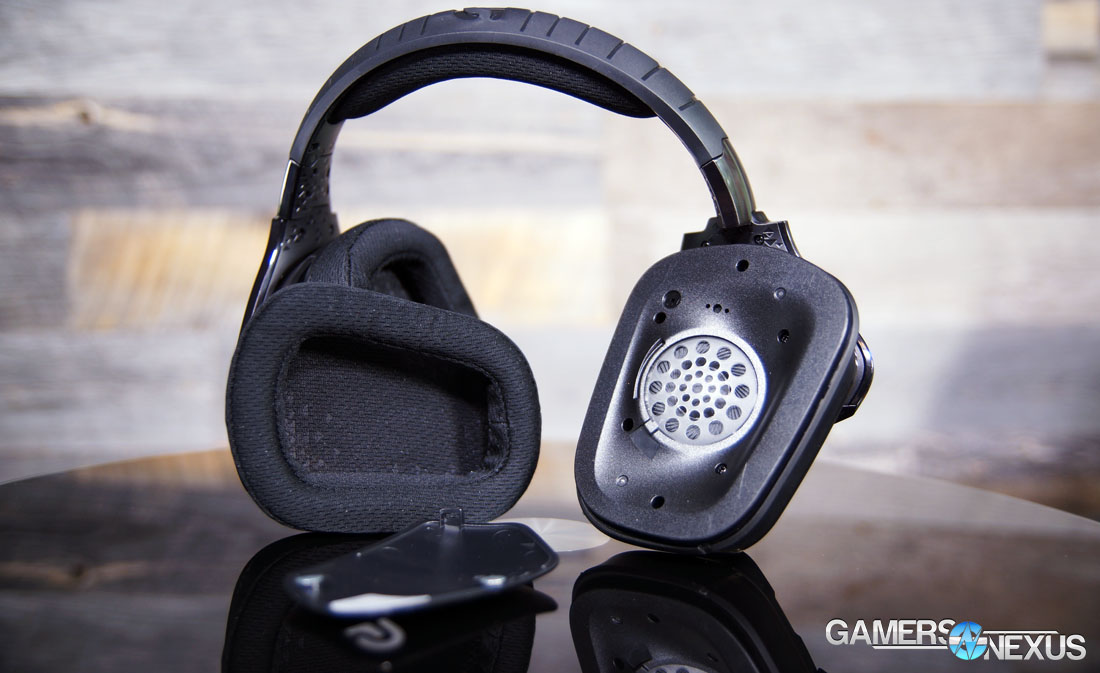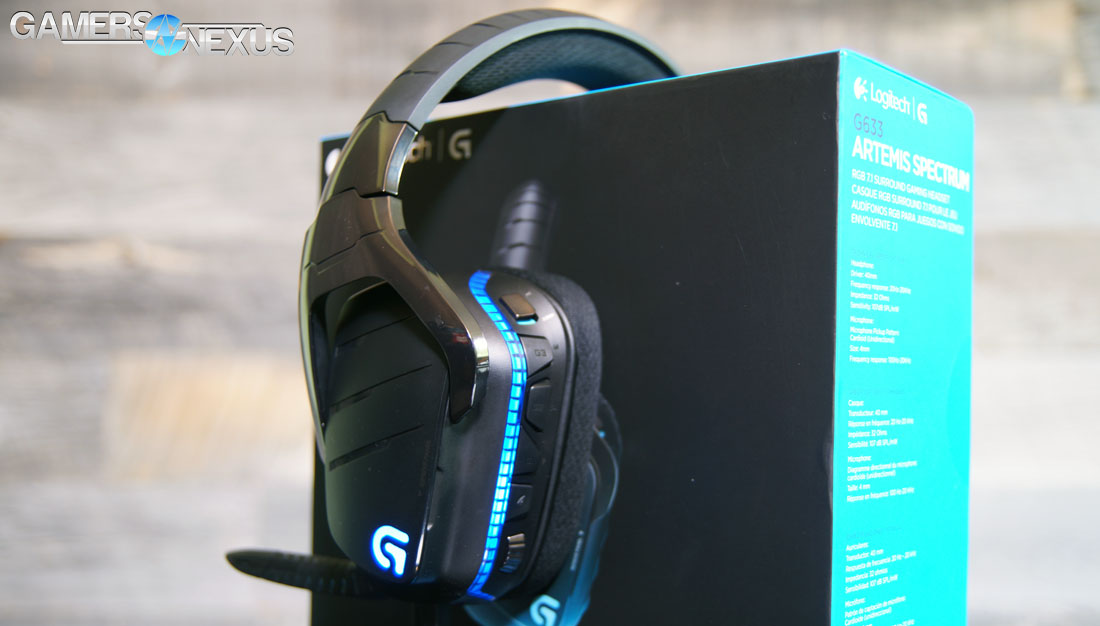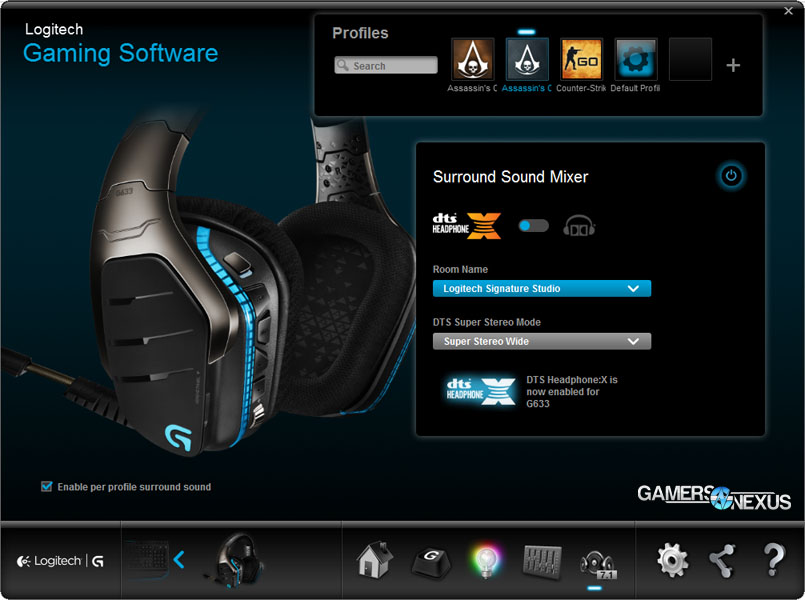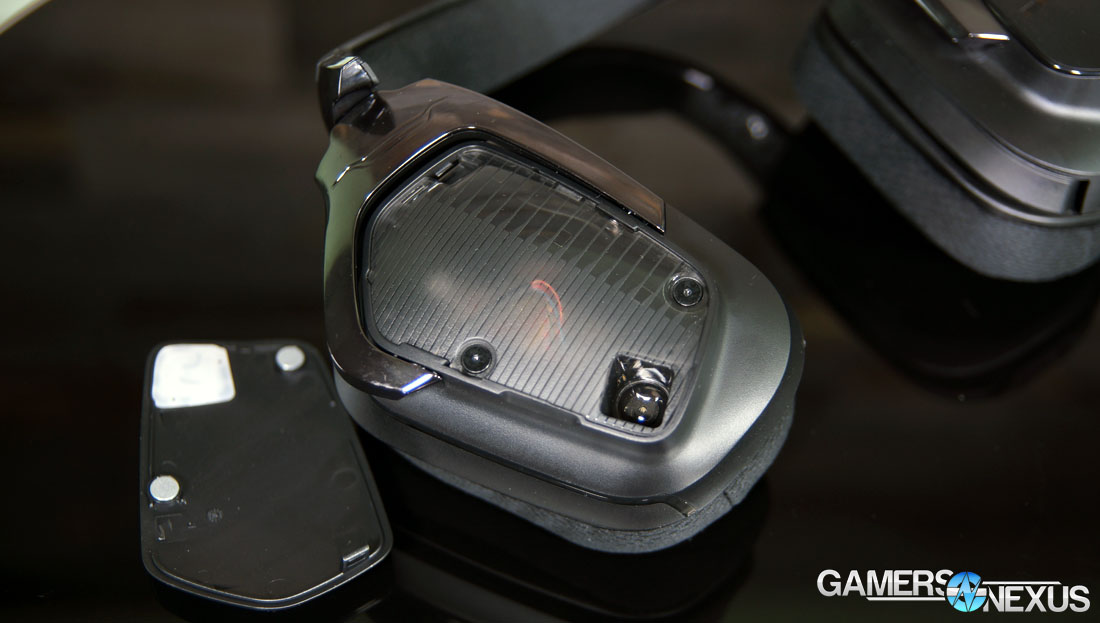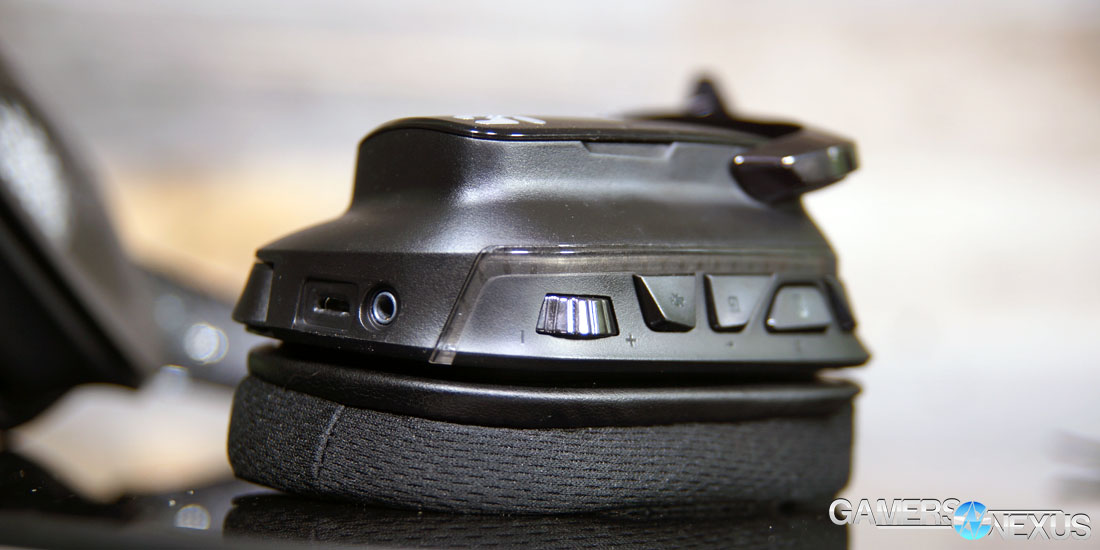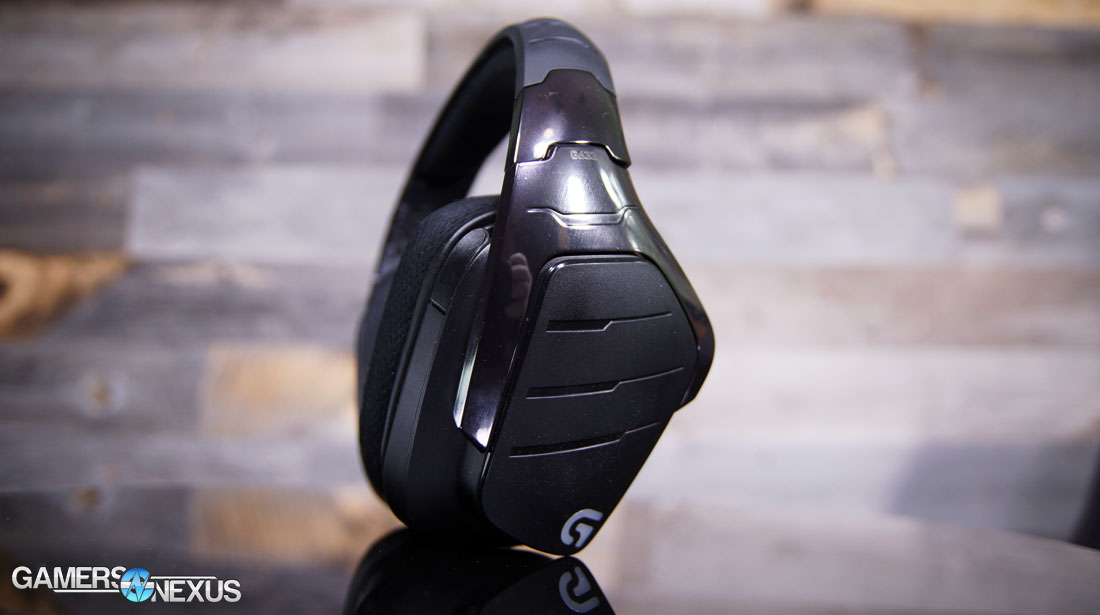Logitech's newest headsets run the high-end of the gaming market, priced at $150 and $200 for the respective wired and wireless variants. We showed the engineering and “making of” behind the company's G633 ($150) and wireless G933 ($200) headsets last month, briefly explaining the Logitech Pro G driver.
The two headsets are boasted by Logitech as the company's return to gaming audio, further claimed to exceed the usual “good for a gaming headset” quotation. Logitech wants its “Artemis Spectrum” headsets – the G633 and G933 – to be recognized for performance across various use cases, primarily including gaming, music, and movie / entertainment categories. Our favored audio solutions specialize in single categories, so the attempt at versatility requires more comprehensive testing and analysis.
This Logitech G633 gaming headset review looks at the RGB LEDs, 7.1 surround sound setup through DTS & Dolby, comfort, build quality, and mic quality.
Logitech G633 Specs
| Part Number | Logitech 981-000586 |
| Driver | Logitech Pro G 40mm |
| Frequency Response | 20Hz-20KHz |
| Impedance | 39 Ohms (passive) 5k Ohms (active) |
| Sensitivity | 107dB SPL/mW |
| Microphone Pickup Pattern | Cardioid Unidirectional |
| Size | 4mm |
| Frequency Response | 100Hz-20KHz |
| Connection | 3.5mm Micro-USB to USB |
| Operating Systems | Windows 10, 8, 7 PlayStation 4 Xbox One |
Logitech's G633 uses the company's new “Pro G” driver, a 40mm speaker that's just completed an 18-month development cycle. The driver's virtue is found in its diaphragm coating, which uses an ultra-thin, woven textile rather than the usual stamped plastic sheets. The thinner nature of the coating minimizes resistance to sound waves as it is transferred through the medium, mitigating surface ripple and granting greater uniformity to driver compression. This produces a cleaner sound.
The risk with thinning-out diaphragm coating is simple: It can tear under the vibrational load exerted by driver impact. Logitech tells us that the Pro G driver's selling-point is its lack of sacrifice – the coating is thinner, but a weave composite assures endurance is not forfeited.
Other than the driver, the G633's premiere features can be truncated to RGB LEDs, DTS Headphone X support, and Dolby 3D surround support.
RGB LEDs offer the usual millions-of-colors output, alongside the expected breathing, cycling, and solid color options. The LEDs are positioned outside the wearer's line-of-sight, but could potentially look cool on stream or at LAN events. Logitech uses an additional, more visible LED in the microphone, providing critical mic mute information (alongside an audible 'blip') when the mic is pushed into its stowaway position. Headset RGB LEDs can be synchronized through LGS with other Logitech peripherals.
DTS Headphone X and Dolby 3D both simulate surround sound in the dual-driver headset. The result is an effective 7.1 channels with frequency tuning and “room” configurations (through Logitech Gaming Software, or LGS). The setup allows for “Super Wide” and “Super Front” channel bias, used in unison with “DTS 7.1,” “Logitech Signature Studio,” and “First Person Shooter” tuning. EQ settings provide further user customization, drilling down into frequency-specific dialing. If you wanted to tune for voice in MOBAs or for explosions in Battlefield, that could be done.
Logitech G633 Artemis Spectrum Gaming Audio Quality
A big disclaimer before we go deep: Audio is hard to review. GPUs are complex, but we can run very clear, objective, industry-understood tests to demonstrate performance deltas between brands and cards. Reviewing audio equipment, without a cost-prohibitive studio to plot frequency spectrum and isolation results, we're going almost entirely off of subjective data. We can provide the facts about specs, but when we're talking about quality, it's going to depend on the user. This, by nature, means that you should probably read a few reviews, figure out if you have similar audio preferences to the various reviewers, and then buy (or pass) based on the collected information.
Part of our test methodology included blind tests, where I'd toggle DTS and Dolby settings to a point of no longer knowing which is active, then pick the solution I liked best. This assisted in eliminating bias inherent in understanding the two technologies and their theoretical best use cases, versus their practical output.
Logitech's G633 has enough power to be dangerous when it comes to gaming. The headset is capable of producing tremendously immersive audio, but requires an informed user for best execution. This is where LGS would do well to integrate additional guidance options; information conveyance in LGS is lacking in the department of DTS and Dolby settings, leaving a lot to be desired when it comes to determining where each is best. Ultimately, it comes down to a process of changing the settings, play-testing, and then trying different settings.
Pre-configured EQ profiles generally excel at their targeted genres, especially FPS, which brings-out the footsteps and booms. The MOBA EQ brings voices more to the front of the headset, helping focus the wearer on team communication or dysfunction (this is a practical gain at the cost of overall quality of sound). DTS proves itself in games which better simulate a studio or box, like cockpit-based racing or space sim games. DiRT Rally – a current favorite of mine – and Star Citizen are excellent examples of these. Dead Space is another example of a confined, tuned sound scape for surround tech.
In DiRT Rally, you can hear the gravel kicking up into the underside of the car. Code Masters has done an excellent job of programming positional audio as camera angle changes, and this is amplified by the G633 headset. With the camera on the hood, lower to the ground, that gravel is louder, the engine noise is grittier, and it's easy to positionally locate each of those sources. As we move into the cockpit, more of the exhaust can's rattling can be heard through the back-side of the body, as correlated to the exhaust's location. I intentionally sat still on a course as I let other cars speed past me, and a sort-of Doppler effect can be picked up using DTS. That's going to happen with almost any decent headset, but it's more pronounced and distinctly superior with the G633. The headset does just fine on its own, without the surround tech, but DTS is more than a mere gimmick when it comes to games like these.
In other games, like CSGO, I found DTS and Dolby to be detrimental to my gameplay. They were wholly undesirable and best left disabled. The nature of CSGO is very choke-point-oriented with linear progression; you know precisely where and when your enemy should be at a location based upon spawn timings, and anything outside of immediate threat audio is undesired. DTS and Dolby amplify a lot of the undesirable environment noise (like your teammates running behind you, reloading, and character voices) with the theory of improving immersion, but for competitive CSGO, all you want is the ability to identify closest threats with footsteps and pot-shots. The headset's native audio output, without modification, is identifiably better than using the Dolby 3D and DTS Headphone X add-ons.
Still, for CSGO, we found headsets like the GameCom 788 and HyperX Cloud to perform similarly enough that the difference is nearly irrelevant. It's just too simple of a sound scape, and seriously competitive CS players already know that the game has a culture of legacy hardware and diminished fidelity. You can get by just as well on a $50 headset as you could on the G633.
Dolby has more arguable use cases in games that design for a circular progression, like Call of Duty or Halo, where the map is more dynamic and unpredictable. This is because, in these games, it is of greater interest to know what's behind you, what's above, below; CS is largely fixed to one plane and has a small set of relevant sounds. CoD, Halo, and Battlefield have substantially greater depth and a more complex sound scape, making DTS or Dolby far more relevant. In all the blind tests I ran on myself, I preferred DTS to Dolby every time. In use cases where I didn't like DTS, I found that the native, unmodified audio output was better than both.
Logitech G633 Microphone Quality
The G633's microphone quality is a major let-down and one of the biggest shortcomings of an otherwise good headset. It seems that, through all of our testing, very few headset manufacturers are capable of creating a product that outputs acceptable audio quality for anything more than raw function. The popularity of streaming suggests that more headsets should support a bit more than “good enough” microphones for such endeavors. It's obviously unrealistic to expect studio condenser quality input, but if the far cheaper GameCom 780 and the Vengeance headsets can produce reasonable sound, the G633 should be able to as well.
We put together a clip comparing the audio input for our Sennheiser MD46 reporter mic + R05 recorder (24-bit sound), the GameCom 788, the HyperX Cloud II, and the Logitech G633. This is found in our above video review at the 10:00 mark.
As heard in the recording, the G633 exhibits sibilance (hissing, pronounced 's' and 'st' sounds) and tin, creating a voice that doesn't much sound like its original input. Natural resonance is lacking in the G633's recorded input. The G633 is arguably better than the Cloud II's disappointingly nasally input, but is inferior to the GameCom's mic.
It seems like such an obvious point of improvement for the entire headset industry, and I'm not sure why an integrated mic revolution hasn't yet happened; the advent of streaming begs for a universal, go-to solution for gamers who aren't yet ready for studio-quality microphones.
Continue to Page 2 for music quality, comfort, & conclusion.
Logitech G633 Artemis Spectrum Quality for Music
Dolby and DTS are hit or miss for music. With more blind testing, I found that DTS did well for music like Dream Theater's, where the progressive instrumentation and native surround mixing couple well with the surround solution. For AFI and other, less complex music, I found that DTS diminished the voluminous nature and grit of Havok's yesteryear vocals – they felt like they had less character. All of the instruments sort of hammered into my ears at equal volumes. For these types of bands, I just turned off all the surround options. The headset performs extremely well without surround assistance and doesn't need it in all use cases, especially those in which a more simplistic instrumentation is at play, or where a band may not have mixed in 5.1 or better.
As I felt with the GameCom 788's Dolby surround, the G633's Dolby inclusion just feels kind of unnecessary to me. The headset has such performant native output that I'd almost always opt for DTS or unmodified output, with Dolby generally being ignored. In theory, Dolby provides a better, more amphitheater-like experience -- but it just comes through as muddied and indistinguishable. The sounds take on an omnipresent feeling; it's sort of all around your head, but nothing is particularly clear.
For Dream Theater, Protest the Hero, and jazz, the G633 really pulls ahead of nearby “gaming headset” competition, especially when DTS actually cooperates with the studio mix.
Logitech G633 Comfort
Comfort is among the most critical aspects of anything worn for hours.
The G633 has issues in this department. I've used the headset for about a month now – a little over – and have experienced the same issues the entire time. We normally see a wear-in period where the fit adjusts, but even through that period, the G633 still slides. It slides backwards slightly throughout the start of a gaming session, requiring constant, minor adjustments until the headset finally finds its very limited 'sweet spot.' I can normally get things seated fairly well within the first five minutes of a session, but I'd obviously rather just put it on and leave it there.
To confirm that this wasn't a fitment issue related to having a giant head (and two inches of padding from the hair, of course), I had a few other folks try it on. GN's Keegan Gallick and Patrick Stone both had the same problem, where the headset will slide forwards or backwards until several minute adjustments are made.
This annoyance seems like a design oversight resultant of the more vertical, rear-weighted nature of the ear cups. Headsets with a perfect fit, we've found, are either tighter (to the point of potential discomfort – like the Cloud) or more square (like the Corsair Void and GameCom 780/788) to stabilize the base across a greater surface area. The headset does eventually come to rest, so it's not a total wash, but we'd encourage users to allow for a few-minute burn-in period at the beginning of gaming.
Conclusion: Logitech's G633 a Device-Agnostic, High-Quality Audio Solution
Build quality is high, overall. The headset doesn't have that heavy-duty feel of some alternatives, like the SteelSeries 9H, but is still strong and durable. We're able to flex the headband considerably (shown in the video) without a snap, thanks to the rubberized material used to hold it all together. The ear cups are fat and have great depth to them, which provides some distance from the drivers and makes for a less claustrophobic feeling. Side plates are removable for future, 3D-printed alternatives (templates to be made available to buyers), making for another unique point of differentiation. The same plates, though, are a little too easy to remove by accident when picking the headset up, but there's an acquired technique to bypass this.
I really like that all cables are fully detachable – that's a big plus. The unit ships with a micro-USB to USB cable for PC use (early buyers can request the woven cable that we have, as initial models shipped with a rubberized cable) or 3.5mm cable for phone use. It's compatible with multiple devices and supports profiles through software. Device versatility makes the G633 a “one headset,” applicable for most use cases. I do think it looks a little dorky to walk around with in public, were I to use it with my phone for music, but then again, people walk around with Beats all the time.
The sliding would absolutely drive me crazy if I weren't in a seated position, though.
I still think Dolby Surround is utterly unnecessary, but then again, I've had a history of disapproval of Dolby Surround. If you already know you like Dolby Surround tech, I encourage you to fully ignore my opinion and go about using it – but it's not for me. In the case of the G633, DTS Headphone X offers quality performance when functional, and the native headset output – unmodified with surround solutions – excels wherever DTS is undesirable, like CSGO.
DTS Headphone X holds itself above an ocean awash with the marketing crockery plaguing the audio industry, proving to be an actually useful, immersion-impacting technology when adequately supported. Some games, like those binding the player to a cockpit – Star Citizen, Elite, and DiRT Rally – really benefit from the 3D surround mixing done by DTS. DTS is impressive in its tuning and, should Logitech's developer relations strategy work out, has a promising future of game-tuned audio for playback as designed.
There are a lot of headsets in the ~$150 price range, but not many good ones. Logitech's primary competition comes from Corsair's $130 Void (cheaper, wireless, but fewer features), the $130 SteelSeries Siberia V3 LED headset, SteelSeries 9H headset, and Sennheiser Game Zero at $200. For cheaper options, we like the Cloud II for its travel-readiness (at $100) and the GameCom 780 – still my favorite sub-$100 headset – at $50. Note that the GameCom 780 has been refreshed as the 788, should availability of the former become thin.
- Steve “Lelldorianx” Burke.
